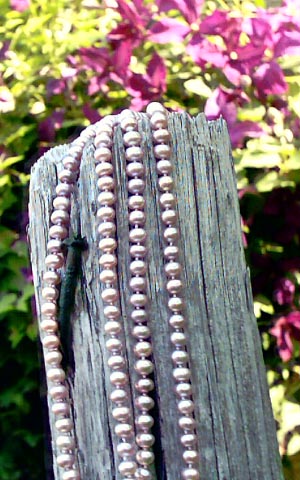|
What Types of China Pearls are Produced?Why are China pearls often a lower price than from other countries? For centuries the Chinese have been acquainted with the China pearls benefit as medicine. Mikimoto even ate two pearls every day. He attributes that habit to his long and healthy life. "I owe my fine health and long life to the two pearls I have swallowed every morning of my life since I was twenty," he said.
The refreshing part of this is that now, financially, pearls are literally within everyone's reach...maybe not top quality pearls...but pearls non-the-less. A negative side to this is lack of universal quality control or grading system. Sellers can pretty much say what they want, make up their own grading system, and buyers are often clueless. Here are some types of China pearls....enjoy. AKOYA PEARLS--Although Akoya pearls are typically exported from Japan, akoya pearl under 7mm are commonly exported from China. The akoya oyster (Pinctada fucata martensii) produces akoya China pearls which are normally cultured, but can also occur naturally. Colors vary from light pink to white to yellowish and are quite round in shape. BLISTER PEARLS--In the 13th century, the Chinese were commonly placing small lead images of buddha inside freshwater mussels against their shells. The mussel would coat these buddhas with nacre making a "pearly buddha." They were either cut off the shell or left on as an ornament and used for a good luck charm. Although Chinese were capable of producing these pearly buddhas they didn't pursue techniques of culturing actual pearls until more recently. Most Chinese pearls today are results of techniques developed by Japanese pearl farmers. However, in the 1960's, Chinese developed a culturing technique using mantle tissue instead of a shell bead for the nucleus, causing the pearl to be all nacre and making it difficult to determine whether the pearl was cultured or natural. See natural pearl tests. KESHI CHINA PEARLS--The terms Keshi refers to several types of pearls. One of its uses is for China pearls which have been "reborn" (Zai Sheng Zhu in Mandarin).When a pearl is carefully removed from the pearl sac of a mussel, so as not to kill the mussel, another pearl will grow in the sack without another implantation of mantle or tissue. These are called "born again" pearls and often erroneously are called "natural pearls" or "keshi pearls." MOTHER OF PEARL BEADS--Note that these, although resembling pearls are NOT pearls, but rather beads ground from the shell. They lack the luster of real pearls but when testing them by rubbing together, they seem like pearls. (See pearl test.) FRESHWATER PEARLS--These are China's most well-known pearls...those grown in freshwater. More than one pearl can be grown in a freshwater mussel, which is one reason that makes these pearls a lower price than sea pearls. The size of freshwater pearls , even in the 1960's was relatively small...however, recently, larger sizes have been developed in various shapes such as coins and crosses and many are baroque shape. Because of their luster, size and smaller price, freshwater pearls are very popular. The term freshwater of course means a river, pond or lake of freshwater which mussels, or oysters grow and produce pearls--usually cultured or started by man. Freshwater pearls, when being developed in Lake Biwi, were nucleated with a shell bead like akoya pearls. Eventually, however, it was discovered that the shell bead wasn't necessary for freshwater pearls, but only a piece of mantle (a membranous tissue which secretes nacre and lines the inner shell surface of mollusks). Also, the developers noticed that a second and third pearl would also grow after the previous pearl was harvested. This, in part, contributes to the normally lower price of freshwater China pearls. This also means that freshwater pearls have more nacre than cultured akoya pearls, which is one of the best selling points for freshwater China pearls. This does however, make it more difficult to detect natural pearls from freshwater pearls. MELO CHINA PEARLS--In the South China Sea, off Malaysia and Singapore, are bailer shells, melon shells or boat shells. Inside these shells can naturally form melo pearls. They're very rare and large weighing up to over 200 carats, usually oval or round. Colors are orange, yellow or brownish with a wavy pattern. |







